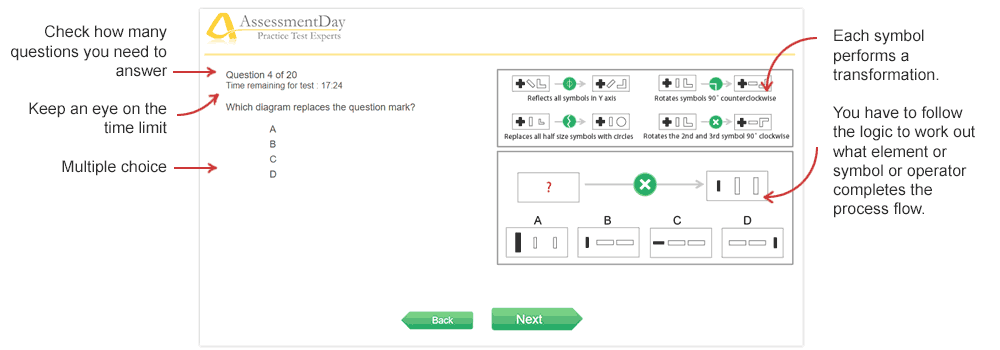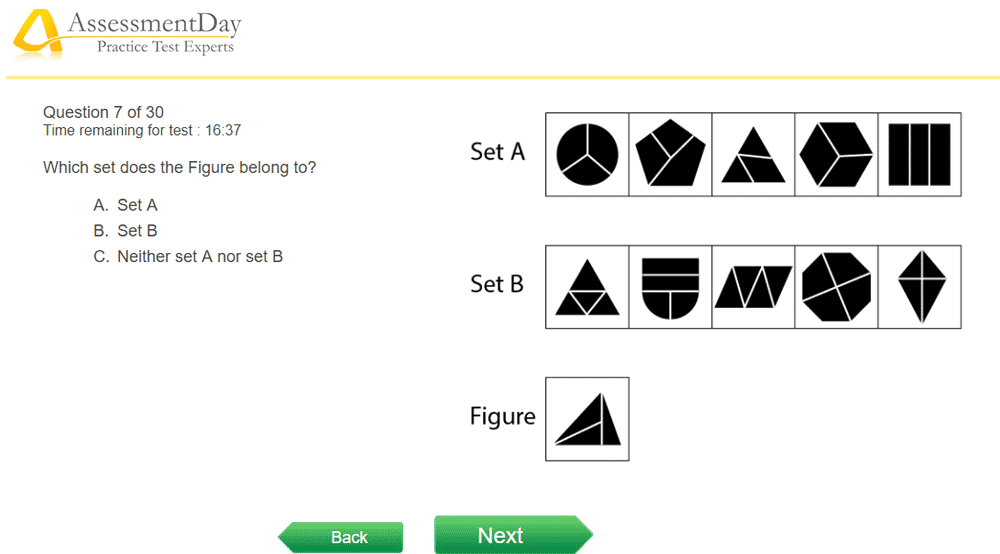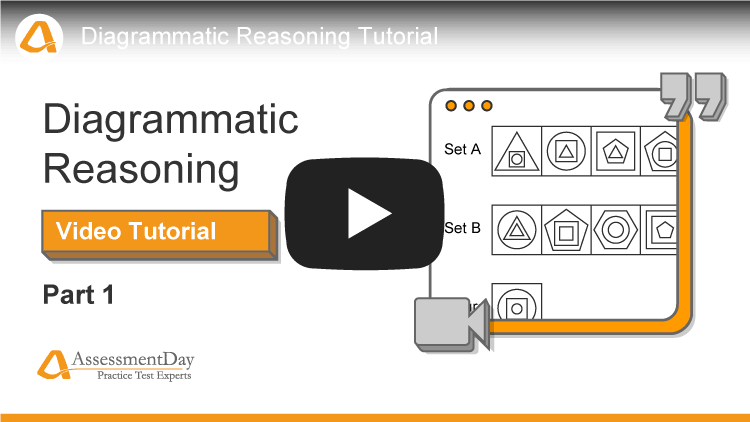Diagrammatic Reasoning Tests
Practice tests, solutions, and tips to help you pass employers' diagrammatic reasoning tests.



Updated:
Diagrammatic reasoning tests and how they work
Diagrammatic reasoning tests (often used interchangeably with abstract reasoning tests) are commonly used aptitude tests used by recruiters to assess a candidate’s ability to think logically and solve complex problems. Candidates applying for roles which require high level of problem solving ability and logical reasoning, such as management consulting, engineering and finance are likely to encounter a diagrammatic reasoning test.
Here are screenshots of our diagrammatic reasoning tests:


Page contents:
Jump to:Looking to hire?
We recommend Test Partnership for companies seeking reliable hiring tests.

What does a diagrammatic reasoning test assess?
Diagrammatic reasoning tests mainly assess a candidate’s logical ability, but will also assess other factors. Skills and abilities assessed during diagrammatic reasoning tests include:
- Analytical ability
- Decision making
- Logical and abstract reasoning
- Critical thinking ability
- Problem solving ability
Compared to other ability tests and other psychometric assessments, diagrammatic reasoning is a very specific skill, requiring only a few similar abilities. For this test candidates will not be required to used any prior knowledge, and the questions on the test will not vary depending on the role or industry recruited for.
For a walkthrough of an example question, watch part 1 of our two-part diagrammatic reasoning tutorial video series below.

Free practice Diagrammatic Reasoning tests
Free Diagrammatic Reasoning Test 1
FreeThis free diagrammatic reasoning test contains 30 questions and has a time limit of 25 minutes.
Free Diagrammatic Reasoning Test 2
FreeThis free diagrammatic reasoning test contains 20 questions and has a time limit of 18 minutes.
Diagrammatic Reasoning Test 1
Premium- 30 questions
- 25 mins
Diagrammatic Reasoning Test 2
PremiumDiagrammatic Reasoning Test 3
PremiumDiagrammatic Reasoning Test 4
PremiumWhat you should know before taking a diagrammatic reasoning test
It is important for candidates to remember that the function of a diagrammatic reasoning test will vary depending on the stage of recruitment it is being used in. If the diagrammatic reasoning test is being given during the early stages of recruitment, for example directly after application, then this test will be used as a screening tool. As a result, poor performance on this test may result in an early screening out of the selection process.
However if the test is being given during the later stages of a recruitment process then this test will be used in conjunction with numerous other tests and exercises, and therefore will not be the sole decider of the selection decision.
Although no prior knowledge is needed, and no materials will be provided for study by the employing organisations, candidates are strongly advised to prepare and research these tests as fully as possible to ensure maximum performance on this test.
There are various different elements to diagrammatic reasoning tests including transition, reflection and rotation to name a few.
Survey results
We surveyed job applicants, who had taken diagrammatic reasoning tests as part of their application process, and asked them what tasks they faced:

Diagrammatic reasoning test advice
- 1. Time limits: These tests will be under timed conditions and candidates will be advised to work both quickly and accurately. These time limits will however be generous enough to allow you to think abstractly and logically, so it is essential to not feel rushed. The timing structure may vary depending on the type of test, some tests may time each question, and some may simply time the entire test.
- 2. Stay calm Diagrammatic reasoning may appear very dissimilar to other types of test and other skills which candidates use in everyday life, and combine this with a time limit and you have a particularly stressful anxiety provoking test. Adequate practice beforehand, enough rest/sleep the night before and plenty of calm deep breathing can go a long way, and help avoid the nervousness associated with psychometric tests.
- 3. Figure out the answer before looking: Candidates are advised to try and figure out the correct answer based on the flowchart before looking at the multiple choice answers. If this is not adhered to then candidates may simply pick the answer which looks like it could be right, rather than figuring out the correct answer and then selecting it. Many of the diagrams in the multiple choice section may look very similar, and without a clear image in your head of what you are looking for, you may fall victim to selecting the wrong one.
- 4. Get clarification on the test: Diagrammatic tests, abstract reasoning tests and numerous other logical reasoning tests are often used interchangeably, therefore candidates are advised to ask the employing organisation what type of test they will be undertaking. True diagrammatic reasoning tests will involve input-output symbols and diagrams; however an abstract reasoning test may involve other mechanisms of testing ability.
Start practising quality tests with a free account
Practice makes perfect
- Learn from detailed solutions
- Track your progress

The most common diagrammatic reasoning tests used by employers
Did You Know?
The only test publishers which use the term diagrammatic reasoning are Saville Consulting and Cubiks. So if you are told you are going to take a diagrammatic test (as opposed to an inductive, abstract, or a logical test) the chances are that the test will have been designed by one of these publishers.
- 1. Saville Consulting Diagrammatic Analysis: - Saville Consulting's diagrammatic tests assess candidates' ability to evaluate processes through diagrams. The stand-alone diagrammatic test is 24 minutes and has 32 questions. If you take this as part of a combined test (such as their Swift series) the diagrammatic element will be shorter: 6 minutes.
- 2. Cubiks / Talogy Diagrammatic Reasoning - The Cubiks diagrammatic test (sometimes referred to as their Reasoning for Business test) asks candidates to analyse two groups of similar symbols, and decide whether a symbol belongs to either group A, group B, or neither group, based on the grouping rules.
How AssessmentDay can help
Practice diagrammatic reasoning tests as offered by AssessmentDay provide an ideal way of practising and preparing yourself for a big diagrammatic reasoning test. Practice diagrammatic tests allow candidates to learn from their mistakes and therefore continually improve. Similarly familiarising yourself with the layout, the questions and being under timed conditions will help dispel the mystery associated with taking a new test. Knowing what you’re up against can be a significant advantage when taking a diagrammatic reasoning test, and help build the confidence needed to succeed.